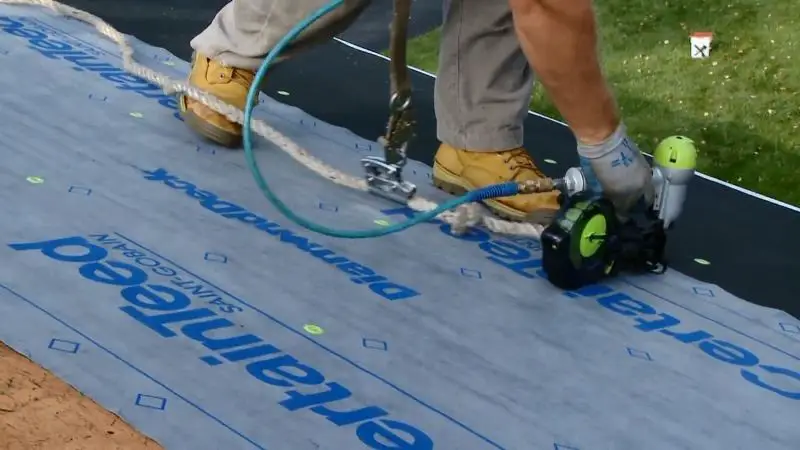Roofing Underlayment Manufacturers List & Website Directory
By Jack Gray, Roof Online Editor • Last updated June 23, 2024
To learn more about roofing underlayment, see our introductory Roofing Underlayment article.
Return to the Roofing Manufacturer Directory Index

What is Roof Underlayment?
Roof underlayment is a protective material applied in sheets directly on the roof deck beneath the main roofing material (whether shingles, tiles, or metal panels). Roof underlayment is typically required by code for most types of pitched roofing. Underlayment serves different purposes, functioning as air barriers or vapor barriers, as protection against ice dams, and as a secondary water barrier. Its primary purpose is to provide an additional layer of protection against water infiltration.
Types of Roofing Underlayment
There are three main types of roofing underlayment:
- Asphalt-Saturated Felt:
- This is the most familiar roofing underlayment and what most people will think of when they imagine what roofing underlayment looks like. It’s commonly called “roofing felt”, “felt paper” or “tar paper”.
- Normally available in two categories, #15 and #30, often somewhat erroneously called “15-pound” or “30-pound” felts. Although these labels no longer accurately correspond to the weight of the material (per square) the #30 felt is thicker and performs better.
- Pros: Relatively inexpensive and easy to install.
- Cons: Less durable compared to your other options and it can wrinkle if exposed to moisture before the roof covering is installed.
- Rubberized Asphalt:
- This type of underlayment consists of a polyester or fiberglass mat coated with asphalt that has been modified by blending the asphalt with synthetic rubber or plastic polymers.
- Typically sold as self-adhering (peel-and-stick) rolls.
- Commonly used along the eaves, which are prone to ice dams, or in valleys, which handle an unusually high volume of water.
- Pros: This material is actually waterproof. It also tends to be self-sealing around nails that penetrate it. It serves as an “ice and water shield”, which is commonly required by code.
- Cons: More expensive than felt and synthetic underlayments. It may not always be appropriate; as a waterproof barrier, it can trap water vapor within the roof deck, preventing the plywood or OSB sheathing from drying out properly.
- Synthetic Underlayment:
- Primarily made from polypropylene and polyethylene, synthetic underlayments are formulated and engineered to be stronger, longer-lasting, and more resistant to moisture than asphalt-saturated felt.
- Tends to be lightweight and will often have an anti-slip surface for safer installation (because it can be very slippery).
- Pros: Highly durable, resistant to tearing, UV-resistant, and provides more coverage per roll compared to felt.
- Cons: Can be very slippery to work on. More expensive than traditional asphalt-saturated felt.
Important Considerations Before Buying Roofing Underlayment
- Climate and Weather Conditions: Take into account the typical weather patterns in your area when deciding on an underlayment. A high-quality synthetic underlayment is probably a good choice for exceptionally rainy climates, for example.
- Roof Type and Slope: The building code specifies the minimum roof pitch and the underlayment requirements for each roofing material and may allow certain materials (such as asphalt shingles) to be used on lower roof slopes provided you install extra underlayment. Some state building codes require special fire-resistant underlayments when installing wood shakes or shingles.
- Roofing Material Compatibility: The underlayment should be compatible with your roofing material. Some materials might work better with specific types of underlayment.
- Roofing Material Quality: It’s a good idea to use high-quality, long-lasting underlayment with high-quality, long-lasting roofing materials. Ideally, you want all parts of a roof system to last at least as long as the primary roofing material does.
- Expected Exposure Time: If you are planning to install underlayment on a new structure and leave it in place as temporary protection for a while before installing the roof, you should check that the underlayment can handle this and for how long.
- Price: Cheaper underlayments may be suitable for cheaper roofs. Consider your budget, but also the need for performance. Trying to save a few dollars on materials may not be worth it in the long run if cheap materials end up costing you a few years off the potential service life of your roof.
Importance of Finding a Good Roof Underlayment Manufacturer
- Quality Assurance: A reputable manufacturer will provide products that are produced using strict quality-control standards to meet industry standards and customer expectations. Their products will tend to be of reliably uniform quality and be less likely to develop unexpected problems, which is important in roofing applications, where failure can lead to costly damage.
- Warranty: Reputable manufacturers will back their products with warranties that protect you in the case of defective materials
- Technical Support: Reputable manufacturers typically offer technical support with a publicly-accessible technical department that will help you choose the right product and provide guidance on proper installation techniques, etc.
- Innovation and Technology: Roofing underlayments are getting better all the time. Established manufacturers invest in research and development to offer cutting-edge products with improved features such as enhanced UV resistance, better slip-resistance, and better adhesion, as well as products that keep water out while letting water vapor through.
- Compliance with Building Codes and Referenced Standards: Reputable manufacturers will ensure that their products comply with local building codes and meet official product standards.
Choosing the right roof underlayment from a reputable manufacturer can help with the long-term performance of your roofing system.
*****
If you represent a reputable and qualified roofing underlayment manufacturer and feel that we’ve overlooked your company, feel free to contact us to ask to be added to this list.
See Roofing Underlayment on Amazon
See Roofing Underlayment at the Home Depot
Roofing Underlayment Manufacturers List
- Alpha Pro Tech
- Benjamin Obdyke Roof and Wall Products
- Carlisle WIP Products
- DuPont Performance Building Solutions
- Epilay
- GAF Materials Corporation
- GCP Applied Technologies (Formerly W.R. Grace)
- Henry Company (Now owned by Carlisle)
- IKO Industries